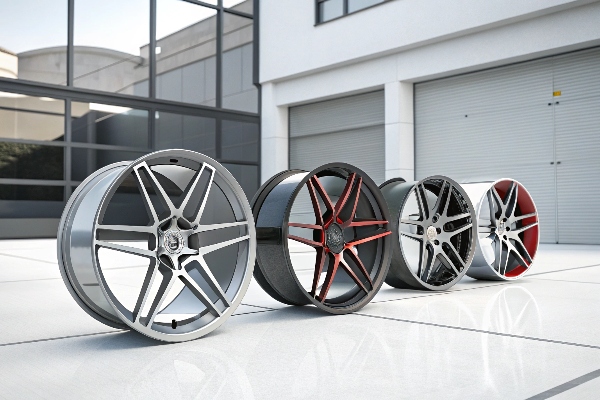I’ve seen some wild car mods, but plastic wheels? That’s a new one. Can wheels really be made of plastic?
Car wheels can’t be made of plastic for standard vehicles. They lack strength and durability. Aluminum, steel, or alloys are used instead.
 concept](https://treewheels.com/wp-content/uploads/2025/04/1-31.jpg)
I love creative ideas, and your question sparks curiosity. Let’s explore why plastic wheels aren’t practical and what materials work.
Are Plastic Wheels Good?
I once saw a toy car with plastic wheels and wondered if it could scale up. Are plastic wheels any good?
Plastic wheels aren’t suitable for cars. They’re weak, heat-sensitive, and unsafe. Aluminum or steel wheels offer better strength and reliability.

Why Plastic Fails
Plastic wheels sound futuristic, but they’re impractical. I’ve tested materials for car parts, and plastic lacks the strength for heavy loads. It deforms under heat from braking. Aluminum or steel wheels handle stress better. Plastic might work for toy cars, but real vehicles need durability. Safety is key, and plastic can’t deliver.
Limited Use Cases
Plastic wheels exist in niche cases, like golf carts or kids’ toys. I saw a plastic-wheeled cart once—it was light but wobbly. For cars, the risks outweigh benefits. Plastic cracks under pressure, unlike alloys. If you’re thinking of custom wheels, stick to forged aluminum, like our Tree Wheels products.
| Material | Strength | Heat Resistance | Common Use |
|---|---|---|---|
| Plastic | Low | Poor | Toys, light carts |
| Aluminum | High | Good | Car wheels |
| Steel | High | Good | Car wheels |
This table shows why plastic isn’t viable. It’s a quick guide to material suitability.
What Material Are Car Rims Made Of?
I’ve customized countless rims, and material choice matters. What are car rims typically made of?
Car rims are usually made of aluminum, steel, or alloys. Aluminum is lightweight and stylish. Steel is durable and affordable.

Common Rim Materials
Most car rims are aluminum or steel. I prefer aluminum for its light weight and sleek look. Alloys, blending aluminum with other metals, boost strength. Steel is heavier but tough and cheap. High-end cars might use carbon fiber, though it’s rare. Each material suits different needs, from budget to performance.
Choosing the Right Material
Your car’s purpose decides the rim material. I once picked steel for a rugged truck—durability won. For sports cars, aluminum improves speed. Check your car’s manual or rim labels for specs. At Tree Wheels, we focus on forged aluminum for premium quality. Always prioritize safety and performance over gimmicks like plastic.
| Rim Material | Weight | Cost | Best For |
|---|---|---|---|
| Aluminum | Light | Moderate | Performance cars |
| Steel | Heavy | Low | Budget vehicles |
| Carbon Fiber | Very light | High | Exotic cars |
This table compares rim materials. It helps you pick the best for your car.
Can a Car Body Be Made of Plastic?
I’ve seen cars with wild designs and wondered about their materials. Can a car body be plastic?
Car bodies can use plastic for parts like bumpers or panels. It’s lightweight but not strong enough for the full body.

Plastic in Car Bodies
Plastic is common in modern cars, but not for entire bodies. I’ve worked with cars using plastic bumpers and fenders. It’s light and cheap but lacks structural strength. Steel or aluminum frames ensure safety. Plastic panels reduce weight, improving fuel efficiency. Full plastic bodies, though, are rare and risky.
Benefits and Drawbacks
Plastic parts are easy to mold and corrosion-resistant. I’ve seen sleek plastic hoods on custom cars. But plastic can’t handle crashes well. It’s best for non-structural parts. For wheels, plastic’s even less practical due to load demands. Stick to metals for safety, like our Tree Wheels forged rims.
| Component | Plastic Use | Common Material |
|---|---|---|
| Car Body | Bumpers, panels | Steel, aluminum |
| Wheels | Not used | Aluminum, steel |
This table clarifies plastic’s role in cars. It’s limited but useful in specific cases.
How Are Plastic Wheels Made?
I’ve always been curious about manufacturing, even for odd ideas like plastic wheels. How are they made?
Plastic wheels are molded using injection molding for toys or light carts. Car wheels use stronger materials like aluminum.

Injection Molding Process
Plastic wheels are made by injection molding. I’ve seen this process in toy factories. Molten plastic is injected into a wheel-shaped mold, cooled, and removed. It’s fast and cheap for small items. But for cars, the plastic would need unreal strength. Aluminum wheels, like ours at Tree Wheels, are forged or cast for durability.
Why It’s Not Scalable
Car wheels face extreme forces—plastic can’t cope. I once saw a plastic wheel crack on a heavy cart. Molding plastic for car wheels would require costly, unproven materials. Forging aluminum is pricier but reliable. Plastic’s environmental impact is also a concern. Metal wheels are recyclable and longer-lasting.
| Manufacturing | Plastic Wheel | Aluminum Wheel |
|---|---|---|
| Process | Injection molding | Forging/casting |
| Strength | Low | High |
| Cost | Low | Higher |
| Use Case | Toys, carts | Cars |
This table compares manufacturing. Plastic works for toys, not cars.
Conclusion
Plastic wheels aren’t practical for cars—stick to aluminum or steel. Tree Wheels offers premium forged wheels for your ride.



